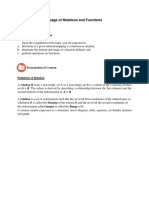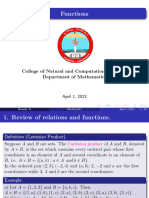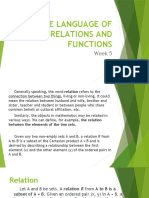III. Relations and Functions
Uploaded by
Rm OtIII. Relations and Functions
Uploaded by
Rm OtTOPIC III: RELATIONS AND FUNCTIONS
WARNING!!! This is for NORSU students copy only. Please do not share or reproduce.
The Language of Relations and Functions
Definition: Let A and B be sets. A relation R from A to B is a subset of A × B. Given an ordered
pair (x, y) in A × B, x is related to y by R, written xRy if and only if (x, y) is in R. The set
A is called the domain of R and set B is called the co-domain.
Notation:
➢ xRy means that (x, y) ∈ R
➢ xRy means that (x, y) ∉ R
Example: Let Y = {0, 1, 2} and Z = {0, 1} and define a relation R from A to B as follows:
Given any (x, y) ∈ Y × Z,
𝑥+𝑦
(x, y) ∈ R means that is an integer.
2
a. State explicitly which ordered pairs are in Y × Z and which are in R.
b. Is 1R0? Is 2R0? Is 2R1?
c. What are the domain and co-domain of R?
Solution:
a. Y × Z = {(0, 0), (0, 1), (1, 0), (1, 1), (2, 0), (2, 1)}. To determine explicitly the
composition of R, examine each ordered pair in Y × Z to see whether its elements satisfy the
defining condition for R.
0+0 0
(0, 0) ∈ R because = = 0, which is an integer.
2 2
0+1 1
(0, 1) ∉ R because = 2, which is not an integer.
2
1+0 1
(1, 0) ∉ R because 2
= 2, which is not an integer.
1+1 2
(1, 1) ∈ R because 2
= 2
= 1, which is an integer.
2+0 2
(2, 0) ∈ R because = = 1, which is an integer.
2 2
2+1 3
(2, 1) ∉ R because = 2, which is not an integer.
2
Thus, R = {(0, 0), (1, 1), (2, 0)}.
b. No, 1R0 because (1, 0) ∉ R.
Yes, 2R0 because (2, 0) ∈ R.
No, 2R1 because (2, 1) ∉ R.
c. Domain => {0, 1, 2}
Co-domain => {0, 1}
Arrow Diagram of a Relation
Suppose R is a relation from set A to a set B. The arrow diagram of R is obtained as follows:
Represent the elements of A as points in one region and the elements of B as point in
another region.
For each x in A and y in B, draw an arrow from x to y if and only if x is related to y by R.
Symbolically:
Draw an arrow from x to y
iff, xRy
iff, (x, y) ∈ R.
Example: Let A = {2, 3, 4} and B = {2, 6, 8} and let R be the “divides” relation from A to B: for
all (x, y) ∈ A × B,
xRy if and only if x | y. (x divides y)
Draw an arrow diagram for R.
Solution:
2 2
3 6
4 8
Directed Graphs of Relation
Another way of illustrating a relation R, especially if R is a relation from a finite set to itself.
▪ First, write the elements of the given set.
▪ Draw an arrow connecting each element x to each element y, where x is related to y.
The diagram is called the directed graph of the relation R.
Example: Let A = {1, 2, 3, 4}. Show the directed graph of the following relation R.
R = {(1, 2), (2, 2), (2, 4), (3, 2), (3, 4), (4, 1), (4, 3)}
Solution: There is an arrow from 2 to itself, since 2 is related to 2 in R.
Definition: A function is a correspondence, or relationship, between two sets called the domain
and range such that for each element of the domain there is a corresponding one element
of the range.
In other words, a relation from A to B is a function F if and only if,
1. Every element of A is the first element of an ordered of F.
2. No two distinct ordered pairs in F have the same first element.
Notation:
➢ If A and B are sets and F is a function from A to B, then given any element x in A, the
unique element in B that is related to x by F is denoted by F(x), which is read as “F of x”.
Example: Let A = {2, 4, 6} and B = {1, 3, 5}. Which of the relations R, S, and T defined below
are functions from A to B?
a. R = {(2, 5), (4, 1), (4, 3), (6, 5)}.
b. For all (x, y) ∈ A × B, (x, y) ∈ S means that y = x + 1.
c. T is defined by the arrow diagram
Solution:
a. R is not a function because it does not satisfy the property number 2. Also, it is clear
when we look at it graphically
b. S is not a function because it does not satisfy property number 1. Also, it is clear when
we look at it graphically
c. T is a function because it satisfies both properties.
FUNCTION MACHINES
To make it more understandable, we can think of a function as a machine. We input a raw
product into the machine, it processes the product, and give us something new which is the output.
In function, suppose f is a function from X to Y and an input x of X is given. Let say that f is the
machine that processes the raw product which is x in a certain way to produce the output f(x).
(NOTE: Draw a machine on the board.)
Functions Defined by Formulas
▪ Squaring Function f from ℝ to ℝ
- defined by the formula f(x) = x2 for all real number x
- which means that no matter what real number input as substitute for x, the output of f
is it’s square
- f: x → x2 ⇨ for which f sends each real number x to x2
▪ Successor Function g from ℤ to ℤ
- defined by the formula g(n) = n + 1
- which means that the output g is always plus than 1 to whatever the real number is
being substituted in n
- g: n → n + 1 ⇨ for which g sends each integer n to n + 1
▪ Constant Function h from ℚ to ℤ
- defined by h(r) = 2 for all rational number r
- which means that whatever rational number r might be, the output would always be 2
- h: r → 2 ⇨ for which h send each rational number r to 2
Example: Suppose x = {-3, -2, -1, 0, 1, 2, 3}. Solve for the f(x), g(x), and h(x) by substituting the
values of x.
a. f(x) = x2
b. g(x) = x + 5
c. h(x) = 8
d. f(x) = x2 – 12x + 36
Solution:
a. f(x) = x2
x -3 -2 -1 0 1 2 3
f(x) 9 4 1 0 1 4 9
f(-3) = (-3)2 = 9 f(-2) = (-2)2 = 4 f(-1) = (-1)2 = 1 f(0) = (0)2 = 0
f(1) = (1)2 = 1 f(2) = (2)2 = 4 f(3) = (3)2 = 9
b. g(x) = x + 5
x -3 -2 -1 0 1 2 3
g(x) 2 3 4 5 6 7 8
g(-3) = (-3) + 5 = 2 g(-2) = (-2) + 5 = 3 g(-1) = (-1) + 5 = 4 g(0) = (0) + 5 = 5
g(1) = (1) + 5 = 6 g(2) = (2) + 5 = 7 g(3) = (3) + 5 = 8
c. h(x) = 8
x -3 -2 -1 0 1 2 3
h(x) 8 8 8 8 8 8 8
h(-3) = 8 h(-2) = 8 h(-1) = 8 h(0) = 8 h(1) = 8 h(2) = 8 h(3) = 8
d. f(x) = x2 – 12x + 36
x -3 -2 -1 0 1 2 3
f(x) 81 64 49 36 25 16 9
f(-3) = (-3)2 – 12(-3) + 36 = 9 + 36 + 36 = 81
f(-2) = (-2)2 – 12(-2) + 36 = 4 + 24 + 36 = 64
f(-1) = (-1)2 – 12(-1) + 36 = 1 + 12 + 36 = 49
f(0) = (0)2 – 12(0) + 36 = 0 + 0 + 36 = 36
f(1) = (1)2 – 12(1) + 36 = 1 – 12 + 36 = 25
f(2) = (2)2 – 12(2) + 36 = 4 – 24 + 36 = 16
f(3) = (3)2 – 12(3) + 36 = 9 – 36 + 36 = 9
A function is an entity of its own, that is, it can be thought of as a certain relationship
between sets or as an input/output machine that operates according to a certain rule.
A relation is a subset of a Cartesian product, while function is a special kind of relation.
Specifically, if f and g are functions from set A to a set B, then
f = {(x, y) ∈ A × B | y = f(x)} and g = {(x, y) ∈ A × B | y = g(x)}.
It follows that, f = g if and only if f(x) = g(x) for all x in A.
Example: Define f: ℝ → ℝ and g: ℝ → ℝ by the following formulas:
f(x) = | x | for all x ∈ ℝ
g(x) = √𝑥 2 for all x ∈ ℝ
Does f = g?
Solution: Yes, because the absolute value of any real number equals the square root of its square,
| x | = √𝑥 2 for all x ∈ ℝ. Hence, f = g.
Example: Define a: ℝ → ℝ and b: ℝ → ℝ by the following formulas:
a(x) = x2 for all x ∈ ℝ
b(x) = (−𝑥)2 for all x ∈ ℝ
Does a = b?
Solution: Yes, because the outcome of the square of any real number equals the squared of its
negative, x2 = (–x)2 for all x ∈ ℝ. Hence, a = b.
References:
Aufmann, R., Lockwood, J., Nation, R., Clegg, D., Epp, S. S. (2018). Speaking Mathematically:
The Language of Relations and Functions (pp. 39 – 48). Mathematics in the Modern World.
Lipschutz, Seymour (1998). Relations: Pictorial Representations of Relations (page 68). Schaum’s
Outline of Theory and Problems of Set Theory and Related Topics 2nd Edition.
You might also like
- Mathematics Module 6 OBJECTIVES: at The End of The Lesson, You Must Be Able ToNo ratings yetMathematics Module 6 OBJECTIVES: at The End of The Lesson, You Must Be Able To10 pages
- Lesson 6 - Language of Relations and FunctionsNo ratings yetLesson 6 - Language of Relations and Functions7 pages
- Lesson 4. The Language of Relations and FunctionsNo ratings yetLesson 4. The Language of Relations and Functions7 pages
- Differential Calculus - Chapter01 - Functions PDF100% (2)Differential Calculus - Chapter01 - Functions PDF149 pages
- Math 1100 Module 2 - Functions To LogicNo ratings yetMath 1100 Module 2 - Functions To Logic13 pages
- Test Yourself: Example 1.3.7 Equality of FunctionsNo ratings yetTest Yourself: Example 1.3.7 Equality of Functions2 pages
- L2.3 - Language of Relations & FunctionsNo ratings yetL2.3 - Language of Relations & Functions7 pages
- Chapter-02: Relations and Functions: Basic Concepts100% (1)Chapter-02: Relations and Functions: Basic Concepts12 pages
- Wikimama Class 12 CH 01 Relation and FunctionNo ratings yetWikimama Class 12 CH 01 Relation and Function12 pages
- SSLC 10th Mathematics English Medium Study Materials Ceo Krishnagiri Dt.No ratings yetSSLC 10th Mathematics English Medium Study Materials Ceo Krishnagiri Dt.90 pages
- Topic 3 Functions and Relations Notes 2023No ratings yetTopic 3 Functions and Relations Notes 202365 pages
- Chapter09 - Graphing Linear Functions and RelationsNo ratings yetChapter09 - Graphing Linear Functions and Relations64 pages
- Lesson 1.A: Functions and Relations: Time Frame: 1st Week (8 Hours) Performance StandardNo ratings yetLesson 1.A: Functions and Relations: Time Frame: 1st Week (8 Hours) Performance Standard10 pages
- Purple Black Metallic Web 3.0 Trending Instagram Story_20241220_173710_0000No ratings yetPurple Black Metallic Web 3.0 Trending Instagram Story_20241220_173710_00001 page
- Ro Ughn the Ice Queen's Rebound Jonas Siblings 01No ratings yetRo Ughn the Ice Queen's Rebound Jonas Siblings 01385 pages
- Science Technology and Society REVIEW NOTESNo ratings yetScience Technology and Society REVIEW NOTES45 pages
- Troop Leading Procedure Definition of Terms50% (2)Troop Leading Procedure Definition of Terms4 pages
- Descriptive Translation of Terms From English Into Russian in The Field of Corporate GovernanceNo ratings yetDescriptive Translation of Terms From English Into Russian in The Field of Corporate Governance559 pages
- Choulli - Carleman and Inverse ProblemsNo ratings yetChoulli - Carleman and Inverse Problems88 pages
- Centum VP Yokogawa Official Training ManualNo ratings yetCentum VP Yokogawa Official Training Manual10 pages
- GenMath 11 - Q1 - Module 3 Evaluating FunctionsNo ratings yetGenMath 11 - Q1 - Module 3 Evaluating Functions14 pages
- Product Data Sheet Deltav Spectral Pat Deltav en 8016568No ratings yetProduct Data Sheet Deltav Spectral Pat Deltav en 80165688 pages
- Math 30-1 Assignment Booklet 1 (2024 Fall) - 3No ratings yetMath 30-1 Assignment Booklet 1 (2024 Fall) - 314 pages
- Genmath q1 Mod4 Solvingreallifeproblemsinvolvingfunctions v2-1-1No ratings yetGenmath q1 Mod4 Solvingreallifeproblemsinvolvingfunctions v2-1-118 pages
- Notes For C5D Graphing Techniques 1st Lecture in Term 3 Week 1No ratings yetNotes For C5D Graphing Techniques 1st Lecture in Term 3 Week 115 pages
- Hydrodynamics of Ship Propellers by J P B Reslin and P A Nders 1995No ratings yetHydrodynamics of Ship Propellers by J P B Reslin and P A Nders 19954 pages
- FIR FILTER Implementation in ARM InstructionNo ratings yetFIR FILTER Implementation in ARM Instruction19 pages
- Mathematics Module 6 OBJECTIVES: at The End of The Lesson, You Must Be Able ToMathematics Module 6 OBJECTIVES: at The End of The Lesson, You Must Be Able To
- Test Yourself: Example 1.3.7 Equality of FunctionsTest Yourself: Example 1.3.7 Equality of Functions
- Chapter-02: Relations and Functions: Basic ConceptsChapter-02: Relations and Functions: Basic Concepts
- SSLC 10th Mathematics English Medium Study Materials Ceo Krishnagiri Dt.SSLC 10th Mathematics English Medium Study Materials Ceo Krishnagiri Dt.
- Chapter09 - Graphing Linear Functions and RelationsChapter09 - Graphing Linear Functions and Relations
- Lesson 1.A: Functions and Relations: Time Frame: 1st Week (8 Hours) Performance StandardLesson 1.A: Functions and Relations: Time Frame: 1st Week (8 Hours) Performance Standard
- Purple Black Metallic Web 3.0 Trending Instagram Story_20241220_173710_0000Purple Black Metallic Web 3.0 Trending Instagram Story_20241220_173710_0000
- Descriptive Translation of Terms From English Into Russian in The Field of Corporate GovernanceDescriptive Translation of Terms From English Into Russian in The Field of Corporate Governance
- Product Data Sheet Deltav Spectral Pat Deltav en 8016568Product Data Sheet Deltav Spectral Pat Deltav en 8016568
- Genmath q1 Mod4 Solvingreallifeproblemsinvolvingfunctions v2-1-1Genmath q1 Mod4 Solvingreallifeproblemsinvolvingfunctions v2-1-1
- Notes For C5D Graphing Techniques 1st Lecture in Term 3 Week 1Notes For C5D Graphing Techniques 1st Lecture in Term 3 Week 1
- Hydrodynamics of Ship Propellers by J P B Reslin and P A Nders 1995Hydrodynamics of Ship Propellers by J P B Reslin and P A Nders 1995














































































































